Sola Emmanuel Owolabi 1, Oluwafemi A. Idowu 2, Bukola Doris Aliu 3
1Readers Services Librarian, Centre for Learning Resources, Landmark University Library, OmuAran, Nigeria
2Kenneth Dike Library, University of Ibadan, Ibadan, Nigeria
3Department of Library Archival and Information Studies, University of Ibadan, Ibadan, Nigeria
Correspondence to: Sola Emmanuel Owolabi , Readers Services Librarian, Centre for Learning Resources, Landmark University Library, OmuAran, Nigeria.
| Email: |  |
Copyright © 2015 Scientific & Academic Publishing. All Rights Reserved.
Abstract
The study investigated awareness and compliance to library rules and regulations by the undergraduate students in Ladoke Akintola University and Obafemi Awolowo University libraries in both in south-western Nigeria. The objectives of the study were to find out the awareness of the undergraduates to the rules and regulations in university libraries, the categories of rules and regulations, the compliance level of the undergraduate students to the existing rules and regulations, the effects of the rules and regulations on library usage as wells as sanctions for defaulting the library rules and regulations. The study adopted a descriptive survey design and random sampling technique was used to select one hundred and fifty respondents in the university libraries. Questionnaire was used for data collection while descriptive statistics was used in analyzing the data. The undergraduate students in LAUTECH and OAU are aware of the rules and regulations in the university libraries and they comply with them very often. The study therefore recommends that: more awareness programmes on the rules and regulations should be created in the university libraries, users should be educated on the need to always comply with the library rules and regulations, stricter measures should be put in place to sanction or penalize any defaulter of library rules and regulations as this will further ensure compliance to the rules and regulations.
Keywords:
Awareness, Compliance, Rules and Regulations, Undergraduate Students
Cite this paper: Sola Emmanuel Owolabi , Oluwafemi A. Idowu , Bukola Doris Aliu , Awareness and Compliance to Library Rules and Regulations by Undergraduate Students in Two University Libraries in Southwest Nigeria, International Journal of Library Science, Vol. 4 No. 1, 2015, pp. 1-6. doi: 10.5923/j.library.20150401.01.
1. Introduction
University libraries are referred to as the hub or heart of universities. Consequently, there is a positive correlation between the quality of services in university libraries and their present institutions. University libraries are the academic units of universities supporting the threefold mandate of universities in fostering teaching, encouraging research and community service. No wonder undergraduate students are introduced to their libraries early in their educational career through the twin processes of library orientation and credit earning user education programmes [3].University libraries, also known as academic libraries, exist to enhance the acquisition of knowledge by their clientele through the provision of reading materials (book and non-book) for the purposes of teaching, learning and research. University libraries today have shifted from the old notion of being the custodian of books to that of being the disseminator of information. The library today is a busy information centre where information is packaged in various formats to the advantage of the users. In other words, the library within the university today is user-centered as a result of provision of Information Communication and Technology (ICT) facilities in Nigeria [7].To ensure that the library provides an environment suitable for the teaching-learning process, library etiquette is a “sine qua non” in university libraries. This encompasses among others, various rules and regulations to guide the undergraduates in their use of the library and also to effectively use of the library resources and its services by them. Therefore, it is the library’s responsibility to ensure that the use of its information sources, resources and services are maximized to benefit its users, hence the necessity for user education programmes.[8] asserted that Nigerian university libraries ought to take user education programme very serious as a means of stimulating the use of library information products and services. In view of the fact that the library is one of the university educational resources and it is a sophisticated information system, undergraduate students can derive maximum benefit from it only if they are taught how to sharpen their information handling skills.Information literacy instruction, having emerged in the 1990s from more traditional “bibliographic instruction” or “user education” activities, has become a core service in academic libraries, and an increasingly important focus in public and other types of libraries. According to [1] the most common skills or activities in information literacy instruction are:• Library tour• Understanding of subject headings and classification• Searching both manual/computerized catalogues• CD-ROM databases• Using microform equipment• AssignmentsThe library rules and regulations are to ensure that all who use the library obtain maximum benefit from its facilities and it also provides legitimacy for punishing the offenders. Undergraduate students must comply with the rules and regulations of the university libraries and library staff instructions. They must subject themselves to the procedures necessary for the safety of the university libraries collections and properties.
1.1. Objective of the Study
• find out whether the undergraduate students are aware of the rules and regulations in place in their respective university libraries;• examine the categories of rules and regulations in relation to their severity as perceived by undergraduate students in the university libraries;• determine the compliance level of the undergraduate students with the existing rules and regulations in the university libraries;• ascertain the relationship between the level of usage of the university libraries by the undergraduates and the existing rules and regulations; • identify the categories of sanctions and penalties given out to the defaulters of these rules and regulations in university libraries.
1.2. Research Questions
• Are the undergraduate students are aware of the rules and regulations in place in their respective university libraries?• What are the categories of rules and regulations put in place in the university libraries under study?• What is the compliance level of the undergraduate students to the existing rules and regulations in the university libraries?• What is the relationship between the level of usage of the university libraries by the undergraduates and the available rules and regulations? • What are the categories of sanctions and penalties given out to the defaulters of these rules and regulations in university libraries?
2. Literature Review
Studies have been carried out by several authors on use/non-use of library and its resources by undergraduate students of higher institutions. Many of such studies are documented in library science literature while some are not published (Onwubiko, 2005). It is highly paramount that students use the library to keep abreast of facts and have rich literatures for their research but it seems most of them are inept in the use of library. [4] reiterated that:There are many myths associated with undergraduate use of academic libraries. The reality is that many come to university unprepared and unequipped to handle the demands of their course work, primarily because they have no experience with large research libraries, do not understand how libraries work, and have not acquired the skills needed to do meaningful research. This is not the fault of the students, but is indicative of the problems inherent in a public school system gone astray.[4] in his exposition on attitude of undergraduate to use of library affirmed that using their university's library for research purposes overwhelms many of these seemingly sophisticated undergraduates. Often they will use the library as a meeting place, to talk to classmates about upcoming exams, or as a quiet place to take a mid-afternoon nap, but when it comes to actually using library resources to reach an end, anxiety is often the result. It is therefore cardinal to have a guide or sets of rules to control students in the use of the library. [5] observes that libraries should formulate policies (including rules and regulations) to ensure effective and efficient use of their information resources. Library policy statements are the regulations, principles, and strategies that help realize the needs of libraries. Since policies are guides to decision-making, they ensure that decisions of the organization or institution are kept in line with their philosophies [2].[6] suggests a need for library rules and regulations on the behavior of library patrons. Reactions to situations such as theft or mutilation of materials, or disruptive behavior, should not be left to an individual staff member's judgment.
3. Methodology
The study employed survey method using structured questionnaire for collection of primary data for this study. The survey research design is one in which a group of people or items is studied by collecting and analyzing data from only a few people or items considered to be representative of the entire group. The target population consist the undergraduate students Obafemi Awolowo University, Ile-Ife and LadokeAkintola University, Ogbomoso libraries in Southwestern Nigeria. The study will be limited to only the registered undergraduate library users in the university libraries. A total of one hundred and fifty respondents was selected for the study from the selected university libraries using a simple random sampling technique. This implies that a total of 75 respondents were drawn from each of the university libraries. This method gives every respondent equal opportunity of being selected. The data collected for this study was analyzed using simple descriptive statistics which consists of tables, frequencies and percentages.
3.1. Data Analysis and Interpretation
One hundred and fifty (150) copies of questionnaire were administered to undergraduate students in two selected universities, that is, LadokeAkintola University and Obafemi Awolowo University, and only eighty-two (82) copies were duly completed and returned. This represents a 54.7% response rate.
3.2. Demographic Characteristics of Respondents
From Table 1, it could be noted that 23(28%) of the respondents from both LAUTECH and OAU were between 18 and 20 years of age, 35(42.7%) were between 21 and 23 years of age, while 19(23.2%) fell within the ages of 24 and 26 and 5(6.1%) were between 27 and 30 years of age.Table 1. Age Distribution of the Respondents
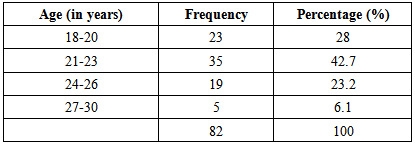 |
| |
|
Table 2 showed the gender distribution of the respondents. About 49(59.8%) of the respondents were males while 33(40.2%) were females. This result reveals that there were more female respondents than male respondents in the selected university libraries of LAUTECH and OAU.Table 2. Sex Distribution of the Respondents
 |
| |
|
Table 3 below contained the level of study of the respondents. It was however revealed that 16(19.5%) of the respondents were in their first year, i.e., 100L, 12(14.6%) were in 200 Level, 20(24.4%) in 300Level, 29(35.4%) were in their final year, 2(2.4%) were in 500 Level and 3(3.7%) were in 600 Level.Table 3. Level of Study of the Respondents
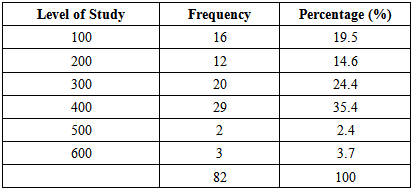 |
| |
|
3.3. Research Questions
Research Question 1: Are the undergraduate students aware of the rules and regulations in place in their respective university libraries?Table 4 revealed 81(98.8%) of the respondents were aware of the library rules and regulations as a result of their library use.Table 4. Awareness of Library Rules and Regulations
 |
| |
|
In Table 5 below. About 57(69.5%) of the respondents got to know about library rules and regulations through library orientation, 6(7.3%) knew through a friend, 31(37.8%) knew as a result of regular visit to the library, while 11(13.4%) knew through the library staff. Apart from this, some undergraduate respondents stated that they got to know about the rules and regulations through library course and notices pasted around the library.Table 5. Knowledge about Library Rules and Regulations
 |
| |
|
Research Question 2: What are the categories of rules and regulations in relation to their severity as perceived by the undergraduate students in the university libraries?Table 6 below revealed that most respondents 81(98.8%) agreed that they were aware that users must be registered in the library, 74(90.2%) agreed that they knew about maintenance of silence in the library, 46(56.1) respondents also indicated that they were aware that group discussion is not allowed in the library, while 51(62.2%) agreed that use of mobile phones is not allowed in the library. In addition, 33(40.2%) were aware of non reservation of seats for friends, 77(93.9%) agreed that food items are not always allowed in the library, 37(45.1%) knew that users should not fight with other library users, few respondents 28(34.1%) knew that consulted books are to be left on the reading table, while 49(59.8%) were aware of proper handling of library materials. Other rules in the library include use of library cards to gain entrance into the library which was agreed by 79(96.3%) respondents, bags not allowed in the reading area which was also agreed upon by 68(82.9%) and only 19(23.2%) respondents were aware of payment of overdue fines in the library. Table 6. Categories of Rules and Regulations in the Library
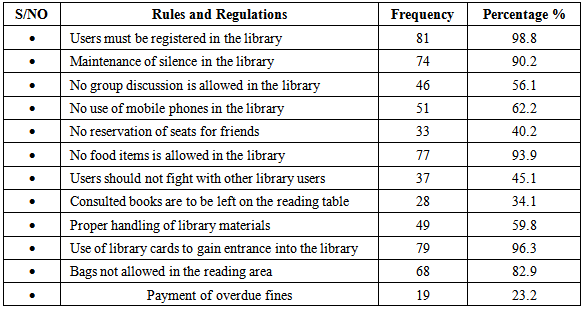 |
| |
|
Research Question 3: What is the compliance level of the undergraduate students to the existing rules and regulations in the university libraries?Table 7 below affirmed that all the 82(100%) respondents indicated that they observe and comply with the library rules and regulations. Table 7. Compliance with Library Rules and Regulations
 |
| |
|
Table 8 below. Majority 48(58.3%) of the respondents indicated that they comply with the library rules and regulations very often, 27(32.9%) always comply with the library rules and regulations while only 7(8.5%) respondents sometimes comply with the library rules and regulations. This therefore implies that the undergraduate students most of the time observe and comply with the library rules and regulations to a reasonable extent.Table 8. Level of Compliance with Library Rules and Regulations
 |
| |
|
Research Question 4: What is the relationship between the level of usage of the university libraries by the undergraduates and the available rules and regulations?Table 9 shows that Majority of the respondents 76(92.7%) advocated that it helps to maintain law and order in the library, 51(62.2%) respondents agreed that it ensures optimum exploitation of the library resources and services, 43(52.4%) affirmed that it allows effective use of the library while 47(57.3%) agreed that it ensures proper handling of library materials. Moreover, almost half of the respondents agreed that it instills discipline in the library users, 49(60%) reiterated that it limits access to some library materials and services, while only 27(32.9%) supported that prevents users from effective use of the library and another 38(46.3%) said it reduces stress on the part of the library staff. Table 9. Effects of Rules and Regulations on Library Use
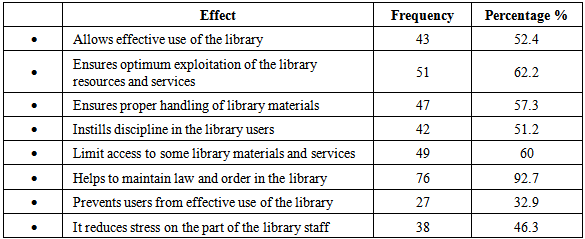 |
| |
|
Research Question 5: What are the categories of sanctions and penalties given out to the defaulters of these rules and regulations in university libraries?Table 10 below shows that 82(100%) of the respondents agreed with use of identification card by students, 81(98.8%) also agreed with submission of bags in the cloak room. Moving round the library to caution users was agreed upon by 65(79.3%) of the respondents, checking the users before they go out of the library was agreed by 79(96.3%) respondents and being friendly with library users to meet their needs with 66(80.5%) response rate. 51(62.2%) respondents indicated directing/guiding users on proper use of the library materials, while 47(57.3%) indicated being available at all times to attend to users’ needs.Table 10. Enforcement of Library Rules and Regulations
 |
| |
|
Furthermore, table 11 shows that majority of the respondents surveyed were not in total support of some sanctions and penalties available for defaulters in the university libraries. This is evident in their responses in which only 31(37.8%) indicated sanction from using the library resources and facilities, 25(30.5%) agreed with withdrawal of user’s borrowing rights, 40(48.9%) indicated suspension from the library, while 42(51.2%) indicated seizure of library ticket. Most of the respondents 78(95.1%) were in strong agreement with payment of fines, as well as warning and cautioning defaulters with 82(100%) responses. While 45(54.9%) supported writing apology letter, only 17(20.7%) agreed with reporting affected user to the higher authority for disciplinary action.Table 11. Categories of Sanctions and Penalties
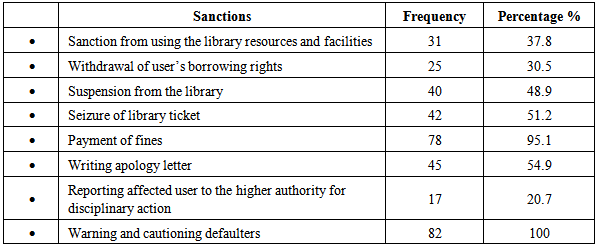 |
| |
|
4. Summary of Findings
This study investigated the awareness and compliance to library rules and regulations by the undergraduate students in LAUTECH and OAU libraries both in south-western Nigeria. The findings of the study are hereby summarized below:It was discovered from the study that virtually all the undergraduate students in LAUTECH and OAU use the university libraries on different occasions; some use it frequently, some very often, some during exams and when the need arises. Consequently, they are all aware of the available rules and regulations in the university libraries. The findings of this study also revealed that there were various categories of library rules and regulations in the LAUTECH and OAU libraries. It was also established from the study that all the undergraduate students in LAUTECH and OAU observe and comply with the rules and regulations available in the university libraries very often. However, it was gathered that the use of the library by the undergraduate students is impacted a lot by the available rules and regulations in the libraries. While some believe the rules and regulations positively related to their level of usage of the university libraries, others believe it negatively affects their use of the library.
5. Conclusions and Recommendations
It was established that the undergraduate students are aware of the rules and regulations in the university libraries and they often observe and comply with the rules and regulations. No doubt, the compliance to the rules and regulations will ensure sanity in the library and guarantee effective utilization of the library resources and services. Furthermore, there seem to be a significant relationship of the rules and regulations in the university libraries and the level of usage of the libraries by the undergraduate students. It was also established that appropriate sanctions and penalties are usually given to the defaulters of rules and regulations in the university libraries. These include payment of overdue fines, cautioning of library users and many more. Based on the findings of this study in the preceding section of this project, the following recommendations were made: • More awareness programmes should be created in the university libraries to enable the undergraduate students to be fully aware of the available rules and regulations so that they can always comply with them. • It is recommended that the problem of shortage of staff should be urgently addressed in the university libraries so that staff can always be available to attend to users needs at all times. • Library users should be further educated through library orientation, and other means on the need to always comply with the library rules and regulations in order to ensure optimum and effective use of the library. • It is recommended that stricter measures be put in place to sanction or penalize any defaulter of library rules and regulations to ensure compliance to the rules and regulations.• Library staff should be friendlier and cooperate with the library users so that they can guide and direct them on the proper use of the library materials and services.
References
| [1] | Alimohammadi, D. and Mahshid, S. 2006. Library Instruction: Past Lessons, Future Plans. Library Philosophy and Practice, 9(1): (Fall). |
| [2] | Clarke, S.O. (1999). Fundamentals of library science. Lagos: Functional publishers. |
| [3] | Igbafe, D. O. E. and Sanni, G. A. 2005. Distractions in university libraries: a case study of the University of Benin, Nigeria. Gateway Library Journal, Vol. 8(1/2): pp. 81-88. |
| [4] | Mason, M. K. 2008. Undergraduate library use: the truth behind the illusion. Retrieved from: http://www.moyak.com/researcher/ resume/index.html on 08/05/2008. |
| [5] | Montuiloff, V. (1990). National information policies: A handbook on the formulation, approval, implementation, and operation of a national policy on information. UNESCO, 180. |
| [6] | Ogbodo, C. I. (2004). In E. C. Duru and M. E. Okon (Eds.), Information use in tertiary institutions in Nigeria. Uyo: Abaam Publishing Company, 71-81. |
| [7] | Onwubiko, M. C. 2005. Use of library resources by sandwich students of Abia State University, Uturu.Gateway Library Journal, Vol. 8(1/2): pp. 42-49. |
| [8] | Popoola, S.O and Zaid, Y.A. (2007) Faculty awareness and use of library information products and services in Nigerian universities. Library Progress (International), (2), 127 137. |

 Abstract
Abstract Reference
Reference Full-Text PDF
Full-Text PDF Full-text HTML
Full-text HTML









